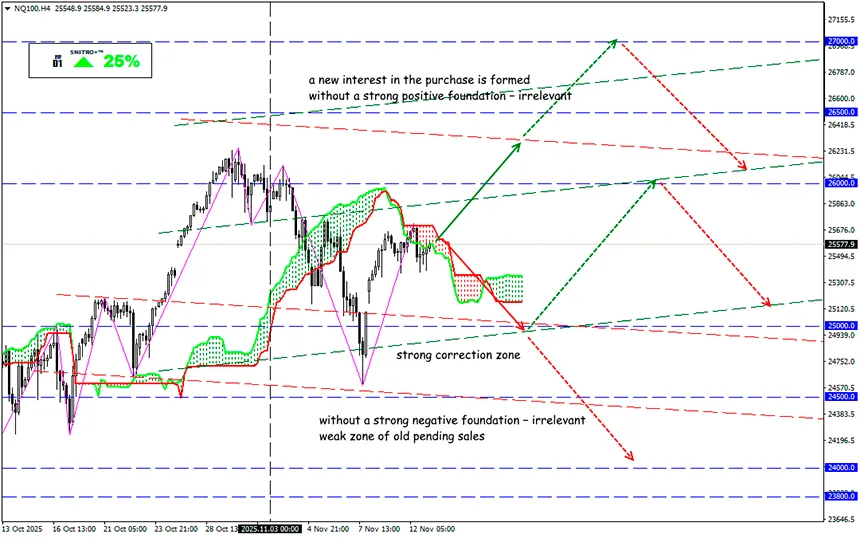How to Survive After the AI Bubble Burst

NQ100
Key zone: 25,400-25,700
Buy: 25,700(after retesting the 25,600 level); target 25,900-29,950; StopLoss 25,600
Sell: 25,350(on strong negative fundamentals); target 25,150-25,100; StopLoss 25,450
Graphic processors have become a new class of financial assets. The main risk of the AI-company “bubble” in the stock market lies in the fact that the growth of their capitalization is detached from real financial performance and the fundamental value of their businesses.
The rapid rise in Nvidia’s stock price is the simplest barometer of AI risk.
For example, the cost of Nvidia’s AI chips has already reached tens of thousands of dollars, making up a significant portion of the $400 billion Big Tech companies plan to invest next year. By 2029, that number could reach $3 trillion.
- The success of leaders (like NVIDIA) causes even unprofitable companies to gain billions in market cap simply because of “AI” in their names or press releases.
- Funds and indices mechanically buy such stocks, amplifying the bias toward overvalued assets.
- Multiples (P/E, P/S) are soaring to levels reminiscent of the dot-com bubble in 1999–2000.
The potential threat of an “AI flash crash” lies not only in valuation errors but also in investors’ forgetfulness about how dangerous asset devaluation can be.
- Unlike investments in industry or construction, AI processors are short-lived assets with a useful life of only 2–5 years.
- Capital expenditures on AI are not one-time costs—they’re recurring. To stay competitive, chip and software upgrades must be constant, which “kills” long-term investment value.
- Energy restrictions limiting data center construction make running older, less efficient chips uneconomical.
- Private credit funds increasingly use AI chips as collateral for loans. Microsoft alone has issued over $60 billion in such loans to risky startups.
- Borrowing to buy and lease chips to clients such as OpenAI or Elon Musk’s xAI is gaining popularity.
- Residual value depends on unpredictable factors—technological change, new chip production, raw material access, or export bans.
No wonder Michael Burry opened a million-dollar short position on AI stocks.
What’s Next?
When expectations fail, investors rush to exit positions, triggering collapses even among strong players.
The relentless AI investment drive resembles an arms race. If the Fed once saved banks, under the new monetary system, the banks may no longer be the biggest problem—the system itself will need saving.
Sam Altman has already suggested that the government should insure AI infrastructure for at least $1 trillion, even though much of it is already outdated. The Fed may have to buy stocks, and the U.S. government might be forced to acquire stakes in key companies—while smaller players will likely vanish.
There’s still time to make decisions using your own, not artificial, intelligence—hedge your risks and don’t chase the crowd.
So we act wisely and avoid unnecessary risks.
Profits to y’all!

















